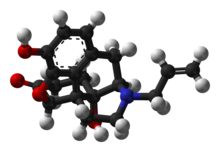- Naloxone
-
Naloxone 

Systematic (IUPAC) name (1S,5R,13R,17S)- 10,17-dihydroxy- 4-(prop-2-en-1-yl)- 12-oxa- 4-azapentacyclo [9.6.1.01,13.05,17.07,18] octadeca- 7(18),8,10-trien- 14-one Clinical data AHFS/Drugs.com monograph Pregnancy cat. B (USA)
B1 (Aus)Legal status Prescription Only (S4) (AU) Routes IV, IM Pharmacokinetic data Bioavailability 2% (90% absorption but high first-pass metabolism) Metabolism Liver Half-life 1-1.5 h Excretion Urine, Biliary Identifiers CAS number 465-65-6 
ATC code V03AB15 PubChem CID 5284596 DrugBank DB01183 ChemSpider 4447644 
UNII 36B82AMQ7N 
KEGG D08249 
ChEBI CHEBI:7459 
ChEMBL CHEMBL80 
Synonyms 17-allyl- 4,5α-epoxy- 3,14-dihydroxymorphinan- 6-one Chemical data Formula C19H21NO4 Mol. mass 327.37 g/mol SMILES eMolecules & PubChem  (what is this?) (verify)
(what is this?) (verify)Naloxone is an opioid antagonist drug developed by Sankyo in the 1960s.[1] Naloxone is a drug used to counter the effects of opiate overdose, for example heroin or morphine overdose. Naloxone is specifically used to counteract life-threatening depression of the central nervous system and respiratory system. Naloxone is also experimentally used in the treatment for congenital insensitivity to pain with anhidrosis (CIPA), an extremely rare disorder (1 in 125 million) that renders one unable to feel pain. It is marketed under various trademarks including Narcan, Nalone, and Narcanti, and has sometimes been mistakenly called "naltrexate." It is not to be confused with naltrexone, an opioid receptor antagonist with qualitatively different effects, used for dependence treatment rather than emergency overdose treatment.
Contents
Pharmacodynamics
Naloxone has an extremely high affinity for μ-opioid receptors in the central nervous system. Naloxone is a μ-opioid receptor competitive antagonist, and its rapid blockade of those receptors often produces rapid onset of withdrawal symptoms. Naloxone also has an antagonist action, though with a lower affinity, at κ- and δ-opioid receptors.
Chemistry
Naloxone is synthesized from thebaine. The chemical structure of naloxone resembles that of oxymorphone, the only difference being the substitution of the N-methyl group with an allyl (prop-2-enyl) group. The name naloxone has been derived from N-allyl and oxymorphone.
Administration
Naloxone is most commonly injected intravenously for fastest action. The drug generally acts within a minute, and its effects may last up to 45 minutes. It can also be administered via intramuscular or subcutaneous injection. Use of a wedge device (nasal atomizer) attached to a syringe to create a mist delivering the drug to the nasal mucosa[2] may also be utilized, although this solution is more likely utilized outside of a clinical facility.
Uses
Counteracting opiate overdose and addiction
Naloxone has been distributed as part of emergency kits to heroin users, and this has been shown to reduce rates of fatal overdose. Projects of this type are under way in San Francisco, New Mexico, Philadelphia, New York State, Baltimore, Boston, Los Angeles, Milwaukee, and Chicago, with pilot projects started in Scotland in 2006[citation needed]. Also in the UK, in December 2008 the Welsh Assembly Government announced intention to establish demonstration sites for ‘take home’ Naloxone.[3] While naloxone is still often used in emergency treatments for opioid overdose, its clinical use in the long-term treatment of opioid addiction is being increasingly superseded by naltrexone. Naltrexone is structurally similar but has a slightly increased affinity for κ-opioid receptors over naloxone, can be administered orally, and has a longer duration of action.
Enteral naloxone has been successfully used in the reduction of gastritis and esophagitis associated with opioid therapy in mechanically-ventilated acute care patients.
The combination oxycodone/naloxone is used for the prophylaxis of opioid-induced constipation in patients requiring strong opioid therapy under the trade name Targin and in the Netherlands under Targinact.[4]
Preventing opioid abuse
Naloxone is used as a secondary chemical in the drug Suboxone. Suboxone and Subutex were created to help opiate-addicted patients detox. Suboxone contains four parts buprenorphine and one part naloxone, while Subutex contains only buprenorphrine. Naloxone was added to Suboxone in an effort to dissuade patients from grinding it up for abuse in combination with opiates. Intravenously administered naloxone is supposed to block the effects of any opiates and cause the user to go into immediate withdrawal. Oral or sublingual administration affects only the gastrointestinal tract, and has the added benefit of helping to reverse constipation and lowered bowel motility caused by chronic medical use, or abuse, of a variety of opioids. Because of possible side effects of naloxone in some patients, chemical detox is often begun with Suboxone's sister drug, Subutex, which does not contain naloxone.
Depersonalization disorder
A 2001 Russian study has shown that naloxone can be used to treat depersonalization disorder. According to the study: "In three of 14 patients, depersonalization symptoms disappeared entirely and seven patients showed a marked improvement. The therapeutic effect of naloxone provides evidence for the role of the endogenous opioid system in the pathogenesis of depersonalization."[5]
Side-effects
Possible side effects include: change in mood, increased sweating, nausea, nervousness, restlessness, trembling, vomiting, allergic reactions such as rash or swelling, dizziness, fainting, fast or irregular pulse, flushing, headache, heart rhythm changes, seizures, sudden chest pain.[6]
Naloxone has been shown to block the action of pain-lowering endorphins which the body produces naturally. The likely reason for this is that these endorphins operate on the same opioid receptors that Naloxone blocks. Naloxone is capable of blocking a placebo pain-lowering response, both in clinical and experimental pain, if the placebo is administered together with a hidden or blind injection of naloxone.[7] Other studies have found that placebo alone can activate the body's μ-opioid endorphin system, delivering pain relief via the same receptor mechanism as morphine.[8]
Legal status
The patent for naloxone has expired. It is available in generic forms.
Identification
The CAS number of naloxone is 465-65-6; the anhydrous hydrochloride salt has CAS 357-08-4 and the hydrochloride salt with 2 molecules of water, hydrochloride dihydrate, has CAS 51481-60-8.
See also
References
- ^ US Patent 3254088 - Morphine Derivative
- ^ "Journal of Emergency Nursing". http://www.jenonline.org/article/PIIS0099176704000078/fulltext?browse_volume=30&issue_key=TOC%40%40JOURNALS%40YJENU%400030%400002&issue_preview=no&select1=no&select1=no&vol=#section7.
- ^ "IHRA 21st International Conference Liverpool, 26th April 2010 - Introducing 'take home' Naloxone in Wales". http://www.ihra.net/files/2010/08/26/Danny_Morris.pdf. Retrieved 9 March 2011.
- ^ Simpson K, et al. (2008 Dec). "Fixed-ratio combination oxycodone/naloxone compared with oxycodone alone for the relief of opioid-induced constipation in moderate-to-severe noncancer pain". Curr Med Res Opin 24 (12): 3503–3512. doi:10.1185/03007990802584454. PMID 19032132. http://www.informapharmascience.com/doi/abs/10.1185/03007990802584454. Retrieved 2009-04-09.
- ^ Nuller YL, Morozova MG, Kushnir ON, Hamper N (June 2001). "Effect of naloxone therapy on depersonalization: a pilot study". J. Psychopharmacol. (Oxford) 15 (2): 93–5. doi:10.1177/026988110101500205. PMID 11448093. http://jop.sagepub.com/cgi/pmidlookup?view=long&pmid=11448093.
- ^ http://www.drugs.com/sfx/naloxone-side-effects.html
- ^ Sauro, Marie D; Greenberg, Roger P. (Feb 2005), "Endogenous opiates and the placebo effect: A meta-analytic review", Journal of Psychosomatic Research 58 (2): 115–120, PMID 15820838, http://maccurtain.com/psych/Sadistic%20Ben%20Mark2/Sauro%20and%20greenburg%202004%20endogenous%20opiates%20and%20the%20placebo%20effect.pdf
- ^ http://www.jyi.org/news/nb.php?id=429
External links
- Chicago Recovery Alliance's naloxone distribution project
- Report on Naloxone and other opiate antidotes, by the International Programme on Chemical Safety
Antidotes (V03AB) Nervous system Barbiturate overdoseBemegride • EthamivanBenzodiazepine overdoseGHB overdoseCardiovascular Other Paracetamol toxicity (Acetaminophen)OtherPrednisolone/promethazine • oxidizing agent (potassium permanganate) • iodine-131 (Potassium iodide) • Methylthioninium chloride#Emetic Categories:- Opioid antagonists
- World Health Organization essential medicines
- Ketones
- Alcohols
- Alkenes
- Phenol ethers
- Semisynthetic opioids
- Morphinans
Wikimedia Foundation. 2010.
